RENAULT MASTER 2017 X62 / 2.G Owner's Manual
Manufacturer: RENAULT, Model Year: 2017, Model line: MASTER, Model: RENAULT MASTER 2017 X62 / 2.GPages: 286, PDF Size: 6.97 MB
Page 21 of 286
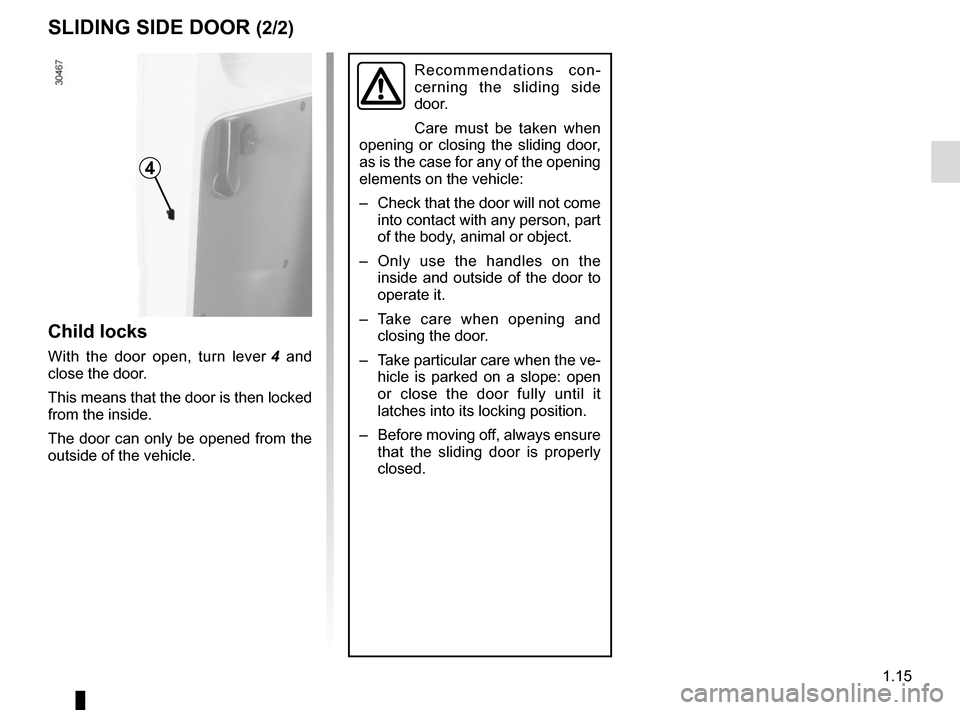
1.15
Recommendations con-
cerning the sliding side
door.
Care must be taken when
opening or closing the sliding door,
as is the case for any of the opening
elements on the vehicle:
– Check that the door will not come into contact with any person, part
of the body, animal or object.
– Only use the handles on the inside and outside of the door to
operate it.
– Take care when opening and closing the door.
– Take particular care when the ve- hicle is parked on a slope: open
or close the door fully until it
latches into its locking position.
– Before moving off, always ensure that the sliding door is properly
closed.
Child locks
With the door open, turn lever 4 and
close the door.
This means that the door is then locked
from the inside.
The door can only be opened from the
outside of the vehicle.
SLIDING SIDE DOOR (2/2)
4
Page 22 of 286
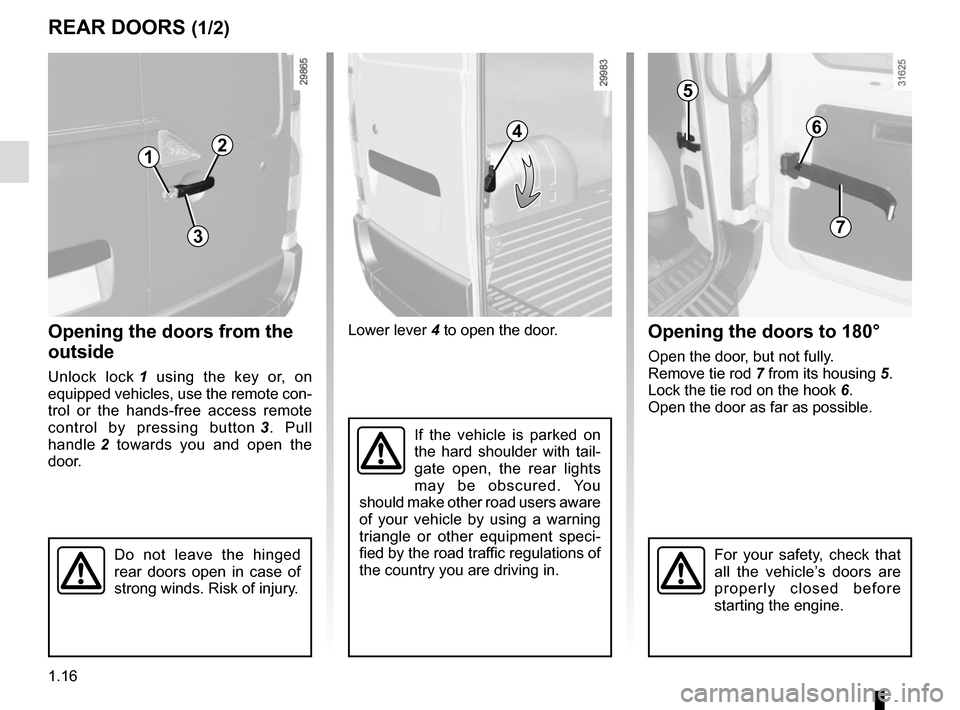
1.16
Lower lever 4 to open the door.
If the vehicle is parked on
the hard shoulder with tail-
gate open, the rear lights
may be obscured. You
should make other road users aware
of your vehicle by using a warning
triangle or other equipment speci-
fied by the road traffic regulations of
the country you are driving in.
REAR DOORS (1/2)
Opening the doors from the
outside
Unlock lock 1 using the key or, on
equipped vehicles, use the remote con-
trol or the hands-free access remote
control by pressing button 3. Pull
handle 2 towards you and open the
door.
Opening the doors to 180°
Open the door, but not fully.
Remove tie rod 7 from its housing 5.
Lock the tie rod on the hook 6.
Open the door as far as possible.
1
24
1
Do not leave the hinged
rear doors open in case of
strong winds. Risk of injury.For your safety, check that
all the vehicle’s doors are
properly closed before
starting the engine.
3
5
6
7
Page 23 of 286
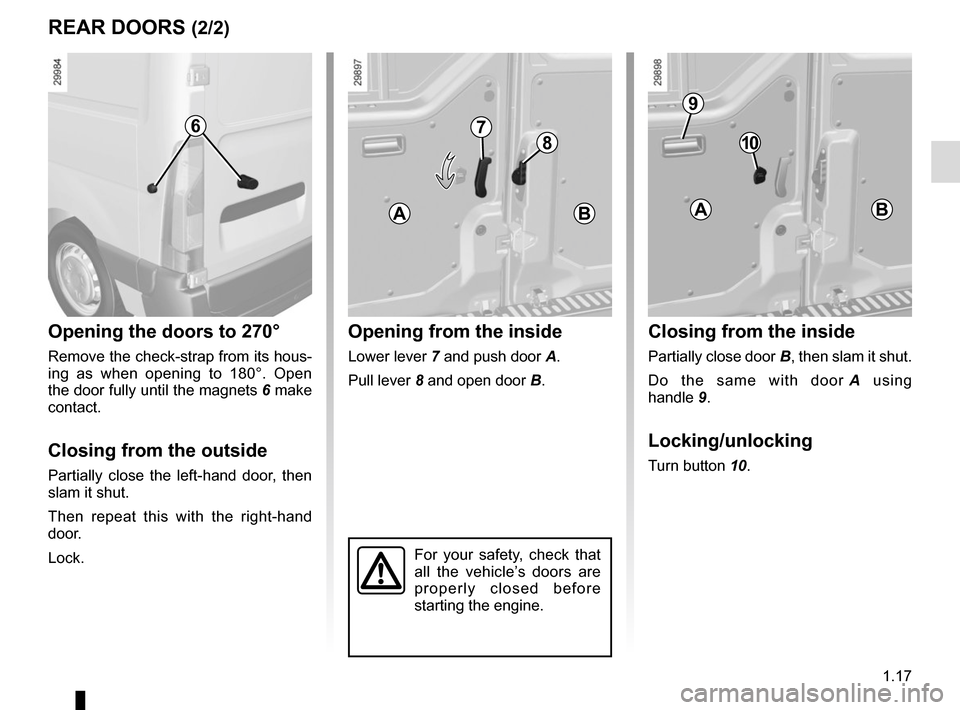
1.17
REAR DOORS (2/2)
Opening the doors to 270°
Remove the check-strap from its hous-
ing as when opening to 180°. Open
the door fully until the magnets 6 make
contact.
Closing from the outside
Partially close the left-hand door, then
slam it shut.
Then repeat this with the right-hand
door.
Lock.
Opening from the inside
Lower lever 7 and push door A.
Pull lever 8 and open door B.
Closing from the inside
Partially close door B, then slam it shut.
Do the same with door A using
handle 9.
Locking/unlocking
Turn button 10.
9
78106
For your safety, check that
all the vehicle’s doors are
properly closed before
starting the engine.
ABAB
Page 24 of 286
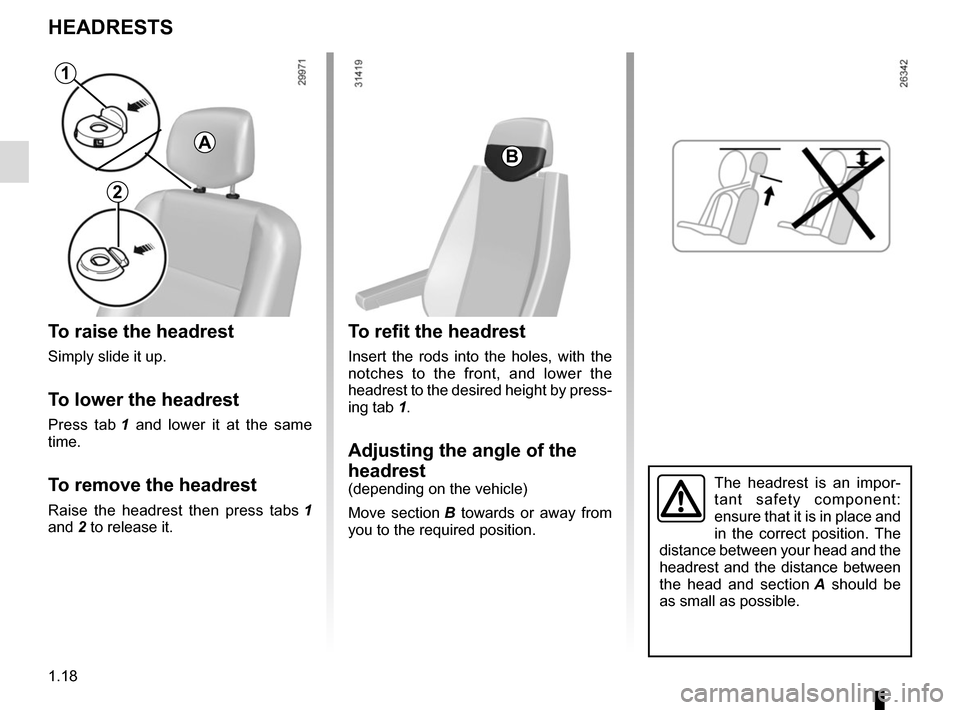
1.18
HEADRESTS
To raise the headrest
Simply slide it up.
To lower the headrest
Press tab 1 and lower it at the same
time.
To remove the headrest
Raise the headrest then press tabs 1
and 2 to release it.
To refit the headrest
Insert the rods into the holes, with the
notches to the front, and lower the
headrest to the desired height by press-
ing tab 1.
Adjusting the angle of the
headrest
(depending on the vehicle)
Move section B towards or away from
you to the required position.
1
2
The headrest is an impor-
tant safety component:
ensure that it is in place and
in the correct position. The
distance between your head and the
headrest and the distance between
the head and section A should be
as small as possible.
AB
Page 25 of 286
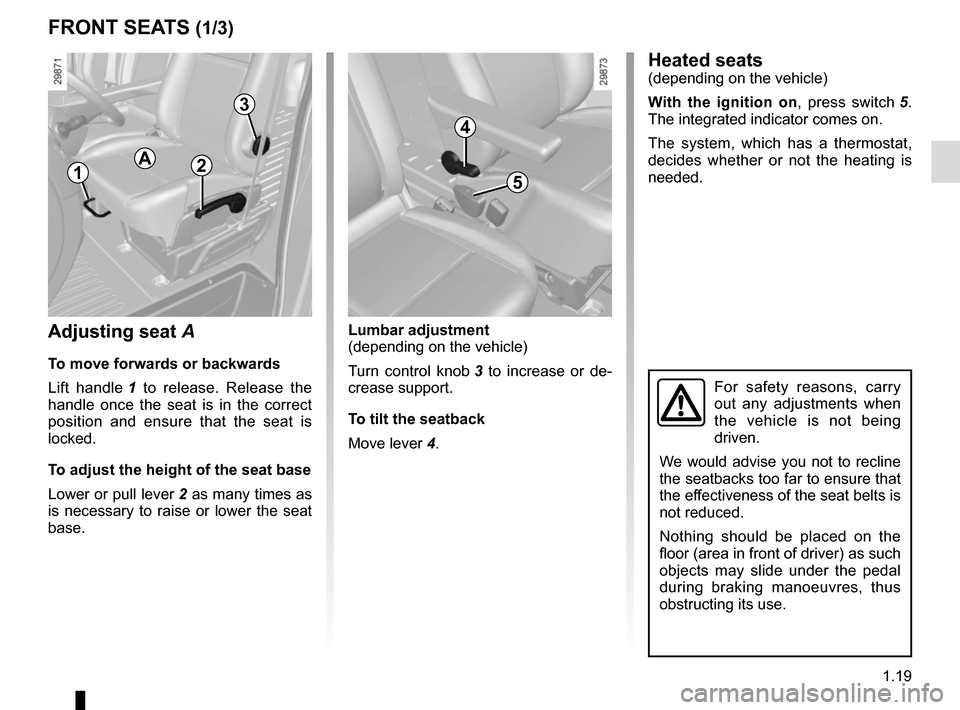
1.19
Lumbar adjustment
(depending on the vehicle)
Turn control knob 3 to increase or de-
crease support.
To tilt the seatback
Move lever 4.
FRONT SEATS (1/3)
Adjusting seat A
To move forwards or backwards
Lift handle 1 to release. Release the
handle once the seat is in the correct
position and ensure that the seat is
locked.
To adjust the height of the seat base
Lower or pull lever 2 as many times as
is necessary to raise or lower the seat
base.
12
3
4
For safety reasons, carry
out any adjustments when
the vehicle is not being
driven.
We would advise you not to recline
the seatbacks too far to ensure that
the effectiveness of the seat belts is
not reduced.
Nothing should be placed on the
floor (area in front of driver) as such
objects may slide under the pedal
during braking manoeuvres, thus
obstructing its use.
Heated seats(depending on the vehicle)
With the ignition on , press switch 5.
The integrated indicator comes on.
The system, which has a thermostat,
decides whether or not the heating is
needed.
5
A
Page 26 of 286
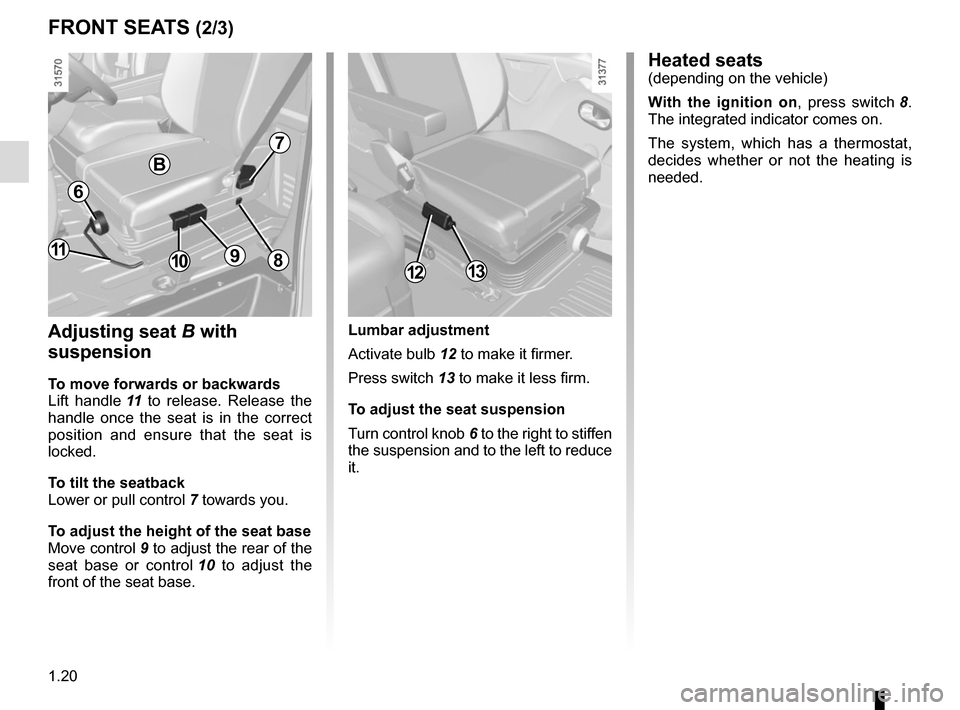
1.20
FRONT SEATS (2/3)
Adjusting seat B with
suspension
To move forwards or backwards
Lift handle 11 to release. Release the
handle once the seat is in the correct
position and ensure that the seat is
locked.
To tilt the seatback
Lower or pull control 7 towards you.
To adjust the height of the seat base
Move control 9 to adjust the rear of the
seat base or control 10 to adjust the
front of the seat base.
6
7
910118
Lumbar adjustment
Activate bulb 12 to make it firmer.
Press switch 13 to make it less firm.
To adjust the seat suspension
Turn control knob 6 to the right to stiffen
the suspension and to the left to reduce
it.
1312
Heated seats(depending on the vehicle)
With the ignition on , press switch 8.
The integrated indicator comes on.
The system, which has a thermostat,
decides whether or not the heating is
needed.
B
Page 27 of 286
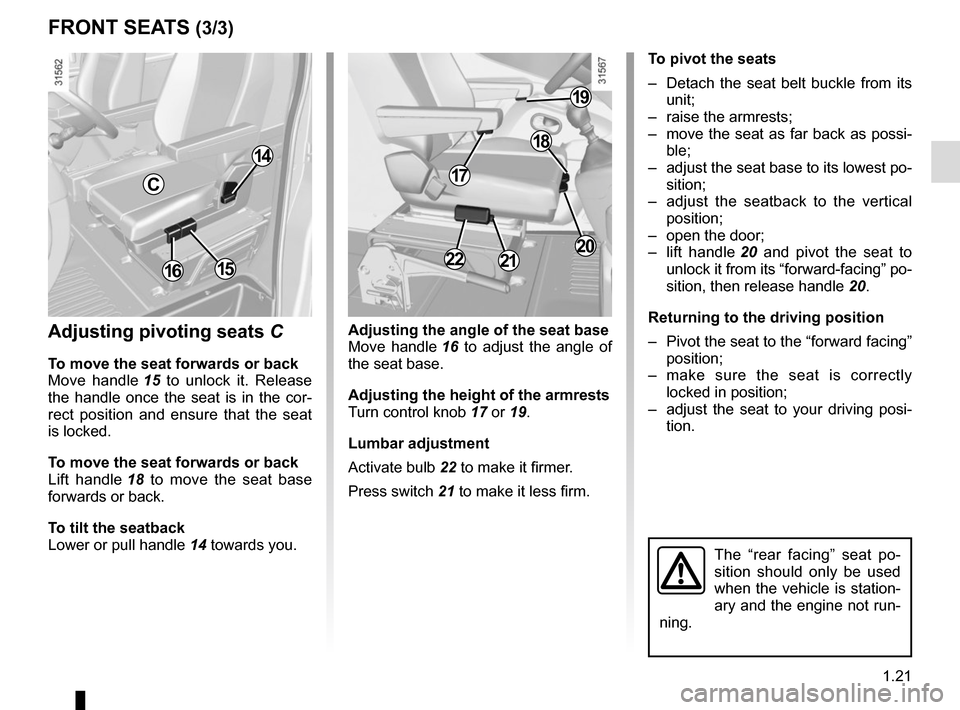
1.21
FRONT SEATS (3/3)
Adjusting pivoting seats C
To move the seat forwards or back
Move handle 15 to unlock it. Release
the handle once the seat is in the cor-
rect position and ensure that the seat
is locked.
To move the seat forwards or back
Lift handle 18 to move the seat base
forwards or back.
To tilt the seatback
Lower or pull handle 14 towards you.
The “rear facing” seat po-
sition should only be used
when the vehicle is station-
ary and the engine not run-
ning.
Adjusting the angle of the seat base
Move handle 16 to adjust the angle of
the seat base.
Adjusting the height of the armrests
Turn control knob 17 or 19.
Lumbar adjustment
Activate bulb 22 to make it firmer.
Press switch 21 to make it less firm.
To pivot the seats
– Detach the seat belt buckle from its unit;
– raise the armrests;
– move the seat as far back as possi- ble;
– adjust the seat base to its lowest po- sition;
– adjust the seatback to the vertical position;
– open the door;
– lift handle 20 and pivot the seat to
unlock it from its “forward-facing” po-
sition, then release handle 20.
Returning to the driving position
– Pivot the seat to the “forward facing” position;
– make sure the seat is correctly locked in position;
– adjust the seat to your driving posi- tion.
14
15162122
18
17
19
20
C
Page 28 of 286
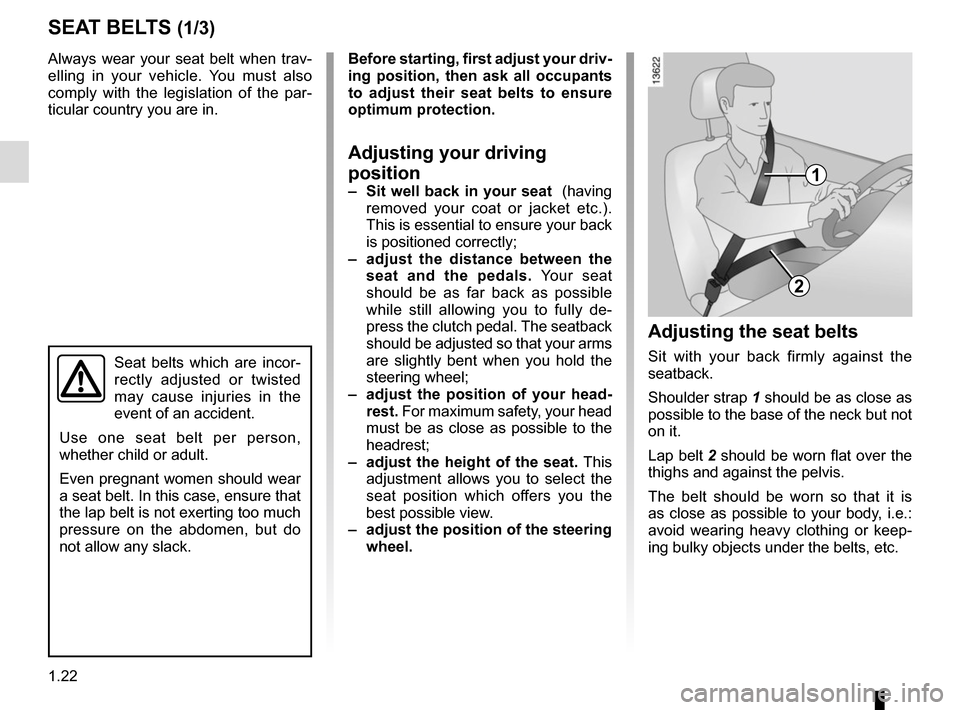
1.22
SEAT BELTS (1/3)
1
2
Always wear your seat belt when trav-
elling in your vehicle. You must also
comply with the legislation of the par-
ticular country you are in.
Seat belts which are incor-
rectly adjusted or twisted
may cause injuries in the
event of an accident.
Use one seat belt per person,
whether child or adult.
Even pregnant women should wear
a seat belt. In this case, ensure that
the lap belt is not exerting too much
pressure on the abdomen, but do
not allow any slack.
Before starting, first adjust your driv-
ing position, then ask all occupants
to adjust their seat belts to ensure
optimum protection.
Adjusting your driving
position
– Sit well back in your seat (having
removed your coat or jacket etc.).
This is essential to ensure your back
is positioned correctly;
– adjust the distance between the seat and the pedals. Your seat
should be as far back as possible
while still allowing you to fully de-
press the clutch pedal. The seatback
should be adjusted so that your arms
are slightly bent when you hold the
steering wheel;
– adjust the position of your head- rest. For maximum safety, your head
must be as close as possible to the
headrest;
– adjust the height of the seat. This
adjustment allows you to select the
seat position which offers you the
best possible view.
– adjust the position of the steering
wheel.
Adjusting the seat belts
Sit with your back firmly against the
seatback.
Shoulder strap 1 should be as close as
possible to the base of the neck but not
on it.
Lap belt 2 should be worn flat over the
thighs and against the pelvis.
The belt should be worn so that it is
as close as possible to your body, i.e.:
avoid wearing heavy clothing or keep-
ing bulky objects under the belts, etc.
Page 29 of 286
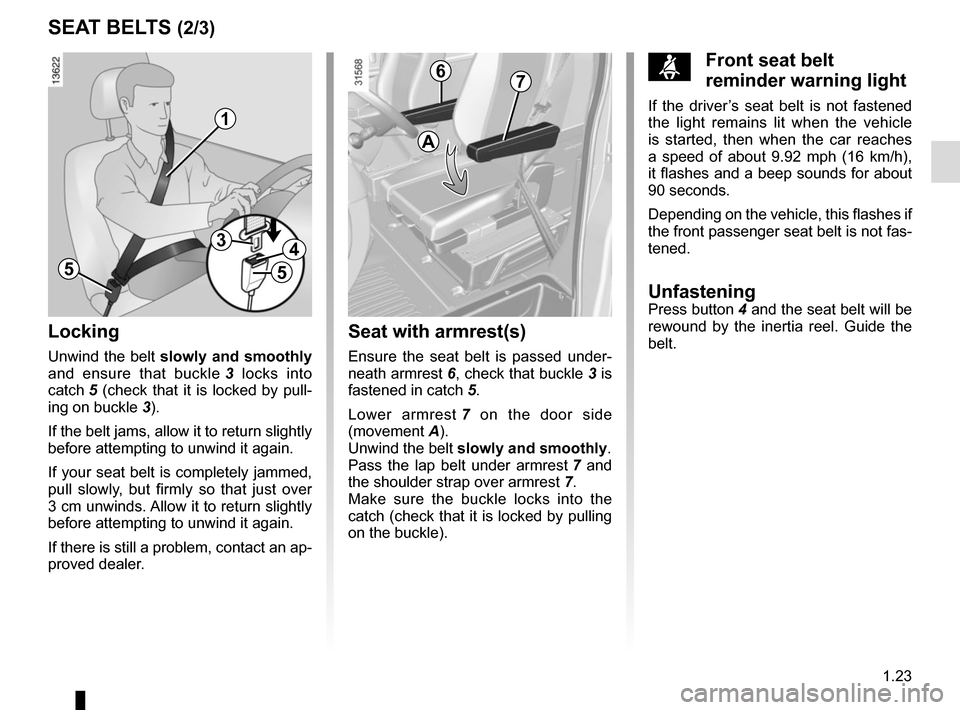
1.23
SEAT BELTS (2/3)
5
34
5
1
Locking
Unwind the belt slowly and smoothly
and ensure that buckle 3 locks into
catch 5 (check that it is locked by pull- ing on buckle 3).
If the belt jams, allow it to return slightly
before attempting to unwind it again.
If your seat belt is completely jammed,
pull slowly, but firmly so that just over
3 cm unwinds. Allow it to return slightly
before attempting to unwind it again.
If there is still a problem, contact an ap-
proved dealer.
Seat with armrest(s)
Ensure the seat belt is passed under-
neath armrest 6, check that buckle 3 is
fastened in catch 5.
Lower armrest 7 on the door side
(movement A).
Unwind the belt slowly and smoothly .
Pass the lap belt under armrest 7 and
the shoulder strap over armrest 7.
Make sure the buckle locks into the
catch (check that it is locked by pulling
on the buckle).
ßFront seat belt
reminder warning light
If the driver’s seat belt is not fastened
the light remains lit when the vehicle
is started, then when the car reaches
a speed of about 9.92 mph (16 km/h),
it flashes and a beep sounds for about
90 seconds.
Depending on the vehicle, this flashes if
the front passenger seat belt is not fas-
tened.
UnfasteningPress button 4 and the seat belt will be
rewound by the inertia reel. Guide the
belt.
A
76
Page 30 of 286
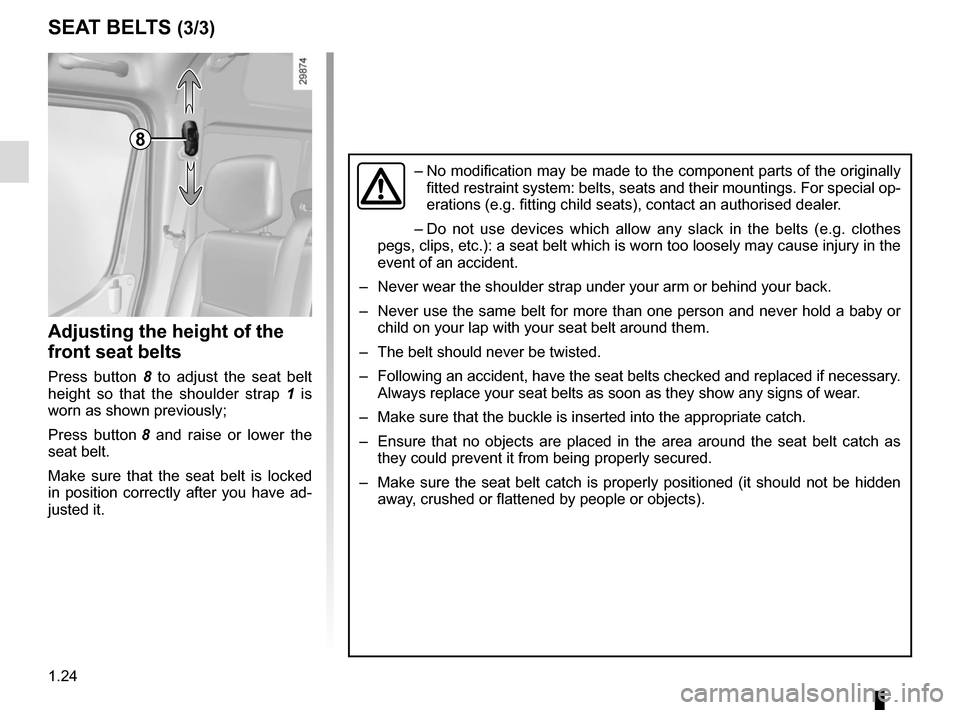
1.24
8
Adjusting the height of the
front seat belts
Press button 8 to adjust the seat belt
height so that the shoulder strap 1 is
worn as shown previously;
Press button 8 and raise or lower the
seat belt.
Make sure that the seat belt is locked
in position correctly after you have ad-
justed it.
SEAT BELTS (3/3)
– No modification may be made to the component parts of the originally
fitted restraint system: belts, seats and their mountings. For special o\
p-
erations (e.g. fitting child seats), contact an authorised dealer.
– Do not use devices which allow any slack in the belts (e.g. clothes
pegs, clips, etc.): a seat belt which is worn too loosely may cause inj\
ury in the
event of an accident.
– Never wear the shoulder strap under your arm or behind your back.
– Never use the same belt for more than one person and never hold a baby o\
r child on your lap with your seat belt around them.
– The belt should never be twisted.
– Following an accident, have the seat belts checked and replaced if neces\
sary. Always replace your seat belts as soon as they show any signs of wear.
– Make sure that the buckle is inserted into the appropriate catch.
– Ensure that no objects are placed in the area around the seat belt catch\
as they could prevent it from being properly secured.
– Make sure the seat belt catch is properly positioned (it should not be \
hidden away, crushed or flattened by people or objects).